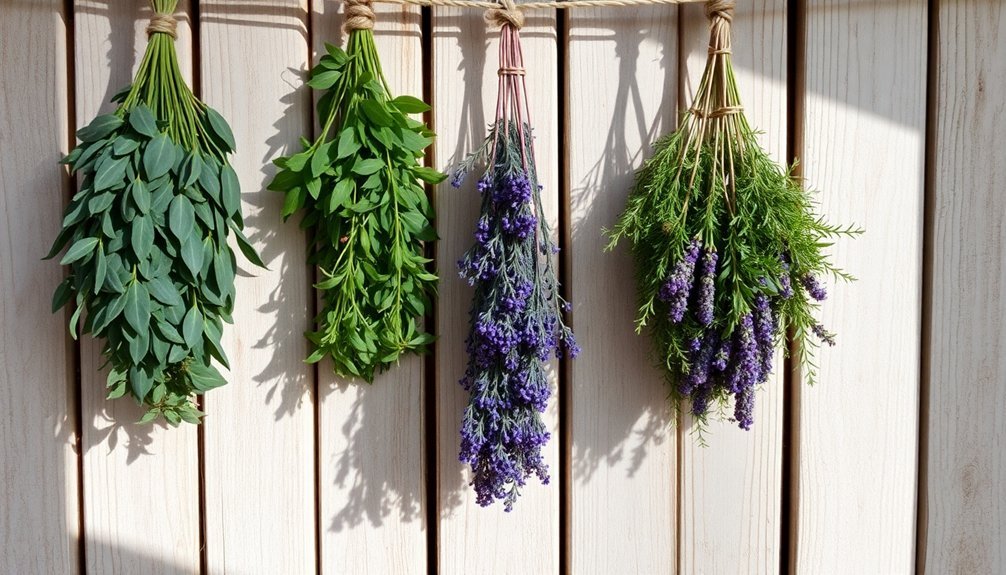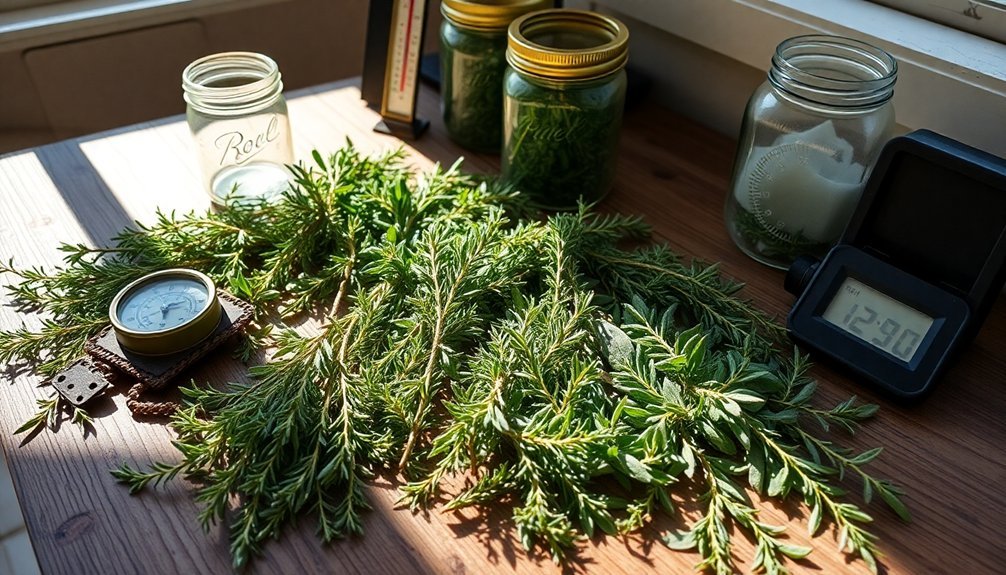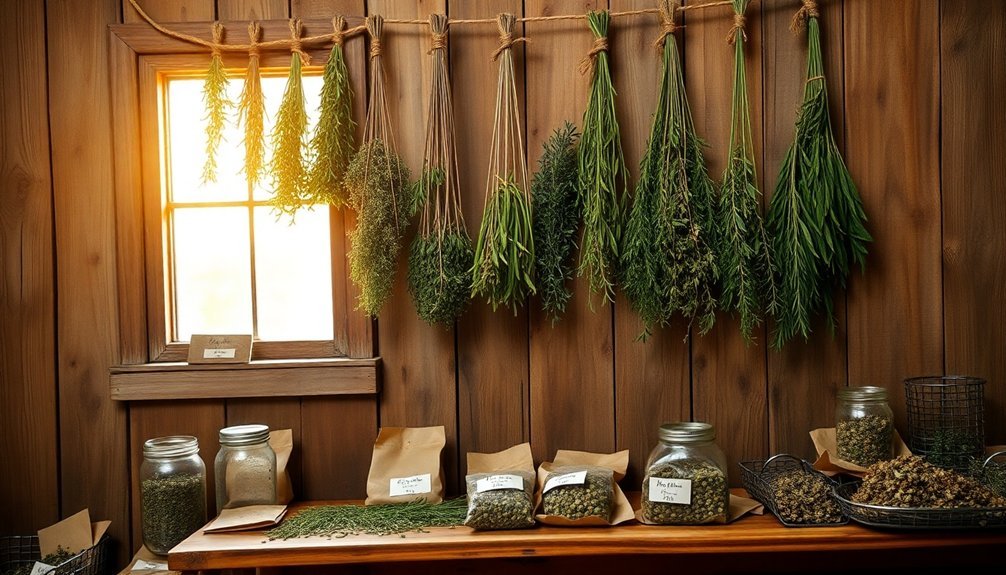You'll get the best results preserving sun-dried herbs using three proven methods. First, air dry your herbs by hanging small bundles upside down in a dark, ventilated space until they're brittle to touch. Next, store your dried herbs in dark glass containers like amber or cobalt blue jars, which block harmful UV rays and maintain freshness. Finally, consider natural steam pasteurization at 102-122°C for 20-40 seconds to eliminate harmful pathogens while preserving flavor. Add silica gel packets to your storage containers and keep them in a cool, dry place. These preservation techniques can access months of aromatic, flavorful herbs for your culinary adventures.
Air Drying for Sun-Dried Herbs

While air drying herbs may seem like a simple process, it requires careful preparation to guarantee the best results.
Start by gathering fresh herbs in the early morning after the dew has dried, removing any damaged leaves and excess stems. If needed, wash and pat them dry to remove dirt or bugs.
Create small bundles about ½ to 1 inch across, keeping different herb types separate. Secure them with twine or rubber bands about ½ inch from the shortest stem's end.
Hang these bundles upside down in a dark, well-ventilated area away from direct sunlight. For delicate herbs, cover the bundles with paper bags to protect them. This method is particularly effective during late summer harvesting when herbs are at their peak.
You'll know they're ready when they feel brittle to the touch, typically after a few days to weeks. Once dried, remove the leaves and crumble them to your desired size.
Storage in Dark Glass Containers
Once your herbs are properly air-dried, proper storage becomes the next key step for long-term preservation. Dark glass containers, especially amber or cobalt blue ones, block up to 99% of harmful UV rays that can degrade your herbs' potency and nutrients. Consider adding small desiccant packs to your containers to maintain optimal dryness and prevent moisture-related issues.
You'll want to store these containers in a cool, dry place away from heat sources like stoves and direct sunlight.
For ideal storage results:
- Choose airtight dark glass containers with secure seals
- Store whole herbs rather than crushed ones to maintain flavor
- Confirm herbs are completely dry before storage to prevent mold
- Label each container with the herb name and drying date
Always check that your storage area maintains consistent temperature and low humidity levels.
This careful attention to storage conditions will help preserve your herbs' flavor, aroma, and medicinal properties for months to come.
Pasteurizing Dried Herbs Naturally

After properly drying your herbs, natural steam pasteurization offers an effective way to eliminate harmful bacteria without chemical treatments. You'll need a steam pasteurization system that uses high-pressure steam at temperatures between 102°C and 122°C for just 20-40 seconds to decontaminate your herbs effectively. Store herbs in airtight, vapor-proof containers after pasteurization to maintain their quality.
| Process Step | Temperature | Duration |
|---|---|---|
| Initial Steam | 102°C | 10 seconds |
| Peak Heat | 122°C | 20 seconds |
| Cool Down | 80°C | 5 seconds |
| Final Dry | Room temp | 5 seconds |
You can use this method for both whole and ground herbs, ensuring they're safe from pathogens like Listeria, Salmonella, and E. Coli. The process maintains your herbs' natural qualities while meeting food safety standards. Best of all, there's no chemical residue, making it perfect for health-conscious consumers who want clean, safe herbs.
Frequently Asked Questions
Can Sun-Dried Herbs Be Rehydrated for Cooking, and How Does It Affect Flavor?
You can rehydrate sun-dried herbs in warm water, broth, or wine for about 30 minutes. They'll release essential oils during rehydration, enhancing flavor, though delicate herbs might lose some intensity compared to fresh ones.
What Signs Indicate Mold Growth on Stored Dried Herbs?
You'll notice fuzzy white, green, or black growths, detect musty odors instead of natural aromas, and find unusual clumping or texture changes. Watch for discolored patches and check if herbs lack their typical fragrance when crushed.
How Do Different Herb Varieties Affect Their Drying Time in Sunlight?
You'll find that basil and mint dry faster due to high moisture content, while thicker-leaved herbs like sage take longer. Oregano dries quickly in bunches, but you'll need to monitor all herbs carefully.
Can Essential Oils Be Extracted From Sun-Dried Herbs?
Yes, you can extract essential oils from sun-dried herbs through steam distillation, but you'll get lower quality and quantity compared to fresh or shade-dried herbs due to the loss of volatile compounds during sun-drying.
Are Sun-Dried Herbs More Potent Than Fresh Herbs in Medicinal Preparations?
Yes, your sun-dried herbs will be more potent than fresh ones in medicinal preparations, as they're typically 3-4 times stronger due to moisture removal. However, you'll need proper drying techniques to maintain potency.
In Summary
You've now learned three effective methods to keep your sun-dried herbs fresh and flavorful. Whether you're air-drying bundles in a well-ventilated space, storing them in dark glass containers away from light, or using natural pasteurization techniques, you'll be able to preserve your harvest's quality for months. These methods will save you money and guarantee you've got homegrown herbs ready whenever you need them.





Leave a Reply